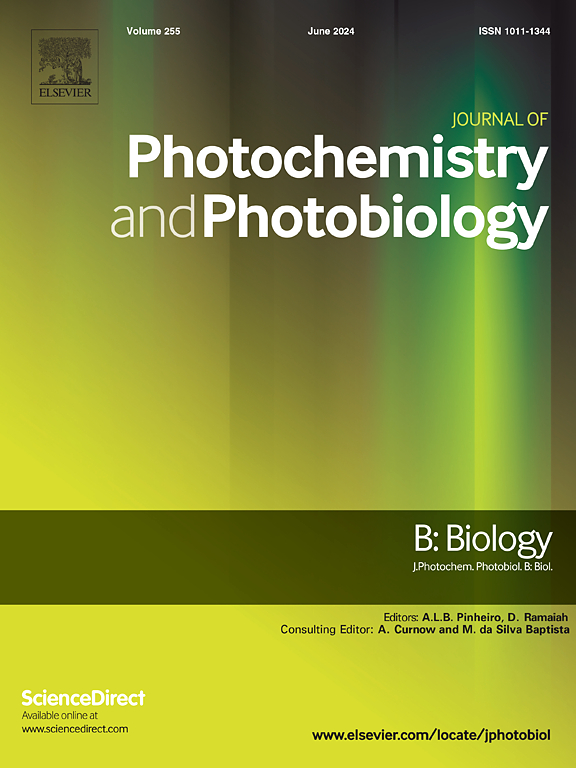与痤疮相关的 UVA 引起的面部荧光:从生理特性到组织结构信息的探索性研究。
IF 3.9
2区 生物学
Q2 BIOCHEMISTRY & MOLECULAR BIOLOGY
Journal of photochemistry and photobiology. B, Biology
Pub Date : 2024-10-02
DOI:10.1016/j.jphotobiol.2024.113042
引用次数: 0
摘要
紫外线诱导面部荧光(UVAF)被认为是量化痤疮严重程度的一种客观测量技术。然而,在不同的研究中观察到的定量结果存在明显的不一致,这可能是由于不同颜色的荧光代表了不同的病理生理学含义。本研究探讨了 UVAF 颜色差异在病理生理学方面的重要性,并提高了其在评估痤疮严重程度方面的可靠性。MIDOO 智能皮肤成像仪用于捕捉 UVAF 并分析荧光颜色与痤疮皮损之间的相关性。双光子激发荧光显微镜、扫描电子显微镜、Western 印迹和高效液相色谱-质谱联用仪(HPLC-MS/MS)等技术被用来检测与不同荧光颜色相关的粉刺栓和毛囊铸型的生化组成和结构。我们发现,绿色荧光与非炎症性痤疮皮损(粉刺)相关,而橙红色荧光与这两种皮损均无相关性。绿色荧光与较高水平的角蛋白有关,表明角质化,而橙红色荧光则与表皮葡萄球菌产生的卟啉有关。UVAF 的颜色差异--橙红色来自卟啉,绿色来自角蛋白。这种区别有助于了解面部荧光的结构和生理基础,对痤疮的临床评估具有潜在的意义。本文章由计算机程序翻译,如有差异,请以英文原文为准。
Acne-related UVA-induced facial fluorescence: An exploratory study from physiological properties to tissue structure information
UVA-induced facial fluorescence (UVAF) is recognized as an objective measurement technique to quantify the severity of acne. However, notable inconsistencies in quantitative outcomes have been observed in various studies, possibly due to the fact that different colors of fluorescence represent different pathophysiological implications. This study investigated the pathophysiological importance of UVAF color differences and improved its reliability in assessing acne severity. MIDOO Smart Skin Imager was used to capture UVAF and analyze the correlation between fluorescence colors and acne lesions. Techniques such as two-photon excited fluorescence microscopy, scanning electron microscopy, western blot, and high performance liquid chromatography-mass spectrometry (HPLC-MS/MS) were used to examine the biochemical composition and structure of comedonal plugs and follicular casts associated with different fluorescence colors. We found that green fluorescence correlates with non-inflammatory acne lesions (comedones), while orange-red fluorescence shows no correlation with either type of lesion. Green fluorescence is associated with higher levels of keratin, indicating keratinization, while orange-red fluorescence is associated with porphyrin from S. epidermidis. UVAF color differences - orange-red are from porphyrins and green from keratin. This distinction helps to understand the structural and physiological bases of facial fluorescence, with potential implications for clinical evaluations of acne.
求助全文
通过发布文献求助,成功后即可免费获取论文全文。
去求助
来源期刊
CiteScore
12.10
自引率
1.90%
发文量
161
审稿时长
37 days
期刊介绍:
The Journal of Photochemistry and Photobiology B: Biology provides a forum for the publication of papers relating to the various aspects of photobiology, as well as a means for communication in this multidisciplinary field.
The scope includes:
- Bioluminescence
- Chronobiology
- DNA repair
- Environmental photobiology
- Nanotechnology in photobiology
- Photocarcinogenesis
- Photochemistry of biomolecules
- Photodynamic therapy
- Photomedicine
- Photomorphogenesis
- Photomovement
- Photoreception
- Photosensitization
- Photosynthesis
- Phototechnology
- Spectroscopy of biological systems
- UV and visible radiation effects and vision.

 求助内容:
求助内容: 应助结果提醒方式:
应助结果提醒方式:


